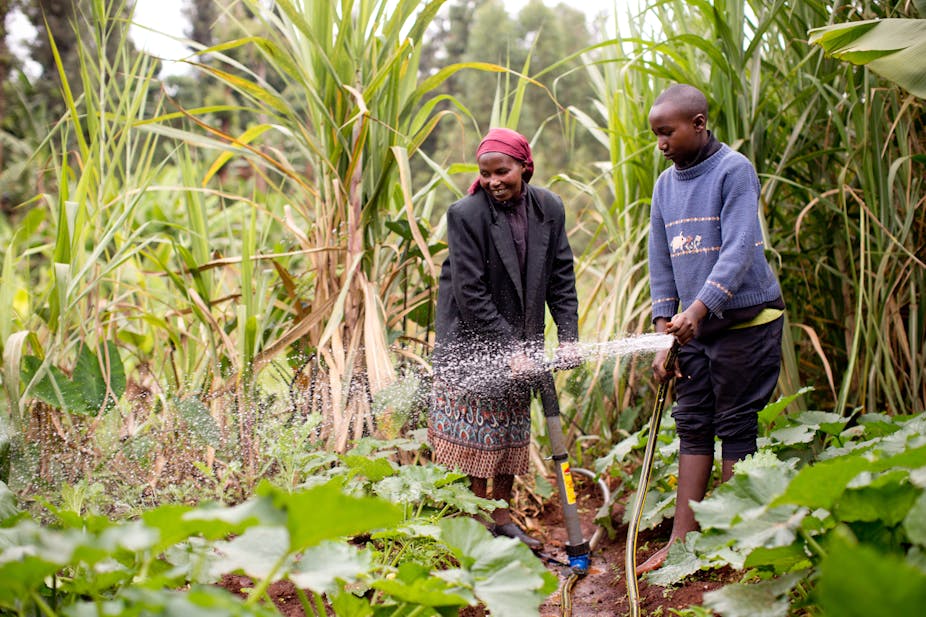Designers aim to change peoples’ lives, ideally for the better. The American co-founders of design and development company KickStart, Martin Fisher and Nick Moon, set themselves a particularly difficult challenge: to design something that could change the lives of poor Kenyan farmers.
The resulting product, which has proved instrumental in creating wealth, improving health and developing businesses in sub-Saharan Africa, is a water pump.
As the name suggests, the KickStart MoneyMaker pump’s ultimate function is not irrigation. Rather, it functions as a tool to move some of the poorest people in Africa from subsistence to commercial farming. To tackle extreme poverty, Fisher argues “income is development”, and the MoneyMaker was designed for “farmerpreneurs”.
Designing products to alleviate poverty in the developing world is not new. Viennese designer Victor Papanek, in his 1971 classic Design for the Real World: Human Ecology and Social Change, chastised Western design professionals for focusing solely on superficial products for wealthy consumers.
Following the “Appropriate Technology” approach, Papanek advocated designing low-cost, small-scale, locally made products for third world needs. An exhibition at New York’s Cooper-Hewitt Design Museum in 2007, Design for the Other 90%, revisited these issues, encapsulating the new wave of (re)thinking design and development.
Fisher and Moon began working in aid and development projects in Kenya in the mid-1980s. Disillusioned with the existing infrastructure’s dependence on overseas aid and gifts, they also had first-hand experience of Appropriate Technology’s failings.
Though well-intentioned, Western designers usually resorted to a universal solution regardless of local needs or context. The resulting products were either too expensive or, if locally produced, of poor quality. And giving away products, usually intended for communal rather than individual ownership, meant that often no one took responsibility for them.
With the entrepreneurial individual rather than the “poor victim” in mind, Fisher and Moon founded a non-profit in 1991 that aimed to design products and create a profitable business model. After designing low-cost pit latrines and a brick press, they noted that subsistence farmers in Kenya were relying on seasonal rainfall and carrying buckets of water from wells to irrigate their crops.

Inspired by a bamboo treadle pump developed by International Development Enterprises (IDE) in Bangladesh, KickStart developed several iterations of an irrigation pump for Kenyan conditions. The original MoneyMaker, launched in 1996, was a treadle-operated metal pump that could pull water up to seven metres from a well to an adjacent field.
The next iteration, the Super MoneyMaker, had both this suction capability plus a pressure capability to push water through a pipe and spray it across two acres of land. With such an irrigation tool, a subsistence farmer with a small plot could grow crops all year round, expand production and sell surplus crops.
The design requirements were challenging. The pumps needed to be durable, functional and mass manufactured yet also portable, easily repairable and culturally acceptable. And to avoid the dependency trap, they had to be sold, but at a very low cost. Designed in Nairobi and initially manufactured locally, larger production facilities and lower costs in China eventually shifted much of KickStart’s pump production offshore.
Even so, at US$95 for a large treadle pump, or even $35 for a less powerful hand-operated version, the MoneyMaker is a significant – but apparently worthwhile – cost for an African farmer.

But increasing agricultural income is only part of KickStart’s aim. Establishing a profitable supply-chain in which distributors and retailers also profit by selling pumps is another, and this too has proven sustainable. A major challenge, however, is marketing the pumps to a semi-literate population with little access to modern communication channels.
To date, the most successful marketing has been live demonstrations in villages, a relatively expensive strategy. Although ideally aiming for a completely self-sufficient market, KickStart still relies on grants to subsidise both marketing of the pump and research and development of new products.
In sub-Saharan Africa, almost half the population live on less than US$1.25 a day, according to the UN’s Millenium Development Goals 2013 report. The majority of these people live in rural areas, making agricultural growth crucial to any viable development strategy.
As of May 2014, KickStart have played a role in the Millennium Development Goals project by selling over 240,000 pumps in Kenya, Tanzania and Mali, resulting in over 150,000 new businesses being created along the supply chain. Most importantly, they have reportedly lifted 790,000 people out of extreme poverty.
While design alone cannot solve global poverty, the Moneymaker is clearly making a difference for many Africans.
Read more articles in the Sublime Design series.
Are you an academic or researcher? Is there a design classic – industrial, graphic, urban, architectural, interior or landscape – you would like to write about? Contact the Arts + Culture editor.

